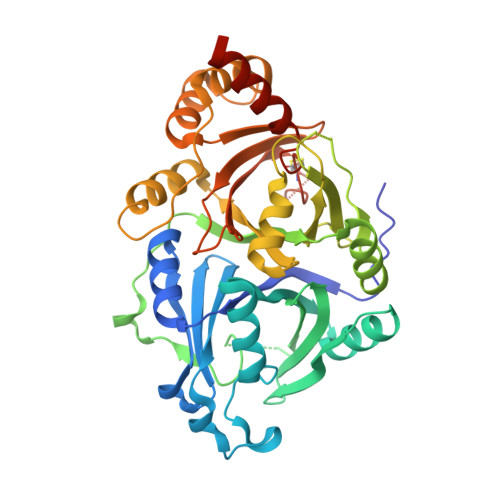Discovery of Subnanomolar Inhibitors of 4-Hydroxyphenylpyruvate Dioxygenase via Structure-Based Rational Design.
Dong, J., Dong, J., Yu, X.H., Yan, Y.C., Nan, J.X., Ye, B.Q., Yang, W.C., Lin, H.Y., Yang, G.F.(2023) J Agric Food Chem 71: 1170-1177
- PubMed: 36599124
- DOI: https://doi.org/10.1021/acs.jafc.2c06727
- Primary Citation of Related Structures:
7X5Y, 7X5Z, 7X62, 7X64, 7X67, 7X69, 7X8H, 7X8I, 7XVH, 8HOW - PubMed Abstract:
High-potency 4-hydroxyphenylpyruvate dioxygenase (HPPD) inhibitors are usually featured by time-dependent inhibition. However, the molecular mechanism underlying time-dependent inhibition by HPPD inhibitors has not been fully elucidated. Here, based on the determination of the HPPD binding mode of natural products, the π-π sandwich stacking interaction was found to be a critical element determining time-dependent inhibition. This result implied that, for the time-dependent inhibitors, strengthening the π-π sandwich stacking interaction might improve their inhibitory efficacy. Consequently, modification with one methyl group on the bicyclic ring of quinazolindione inhibitors was achieved, thereby strengthening the stacking interaction and significantly improving the inhibitory efficacy. Further introduction of bulkier hydrophobic substituents with higher flexibility resulted in a series of HPPD inhibitors with outstanding subnanomolar potency. Exploration of the time-dependent inhibition mechanism and molecular design based on the exploration results are very successful cases of structure-based rational design and provide a guiding reference for future development of HPPD inhibitors.
Organizational Affiliation:
Key Laboratory of Pesticide & Chemical Biology of Ministry of Education, International Joint Research Center for Intelligent Biosensor Technology and Health, College of Chemistry, Central China Normal University, Wuhan 430079, P.R. China.

















